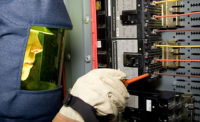With the steady introduction of new technologies into the marketplace and the release of new research results by various public and private groups, the National Electrical Code is perpetually changing. Understanding the reason for these changes enables electricians to more easily absorb and implement new rulings.
Addressing arc flash hazards
110.16 Arc-Flash Hazard Warning requirements have been in the National Electrical Code (NEC) since they were first introduced in the 2002 edition as 110.16 Flash Protection. Each subsequent edition has made minor changes to the wording, but to paraphrase the main requirement, it could simply be stated that the goal is to require owners of the electrical equipment to provide labels that have enough information regarding the potential arc flash hazard that qualified electrical persons can select procedures and personal protective equipment for working on or near the equipment with minimum personal risk.
To aid in compliance with this requirement, the NEC has consistently provided guidance in the Fine Print Notes. [Now known as Informational Notes (I.N.)] The Informational Notes list the NFPA 70E as an aid in determining the severity of potential exposure and ANSI Z535.4 guidelines for safety signs and labeling.
The 2014 NEC adds three items to 110.16.
Switchgear to be labeled
The first is the requirement for these labels to be on switchgear. This is to provide clarification for the requirement. In a previous code cycle, the term “such as” was added to the requirement regarding electrical equipment. Evidently when the NEC says the requirement is for “Electrical equipment such as switchboards, panel boards, industrial control panels, meter socket enclosures and motor control centers that are in other than dwelling units,” it was not clear that this included switchgear. Now it is clear.
Equipment labeling by the manufacturer
The second change is the allowance for the equipment to be factory marked. In 2002, when the requirement was first added, it was clearly a field-marking requirement. What should be noted is that the NEC is an installation requirement and installations are subject to inspection by the authority having jurisdiction (AHJ). The inspection could be delayed on new equipment if only field marking is allowed. The electrical engineer who is providing specifications for the equipment can now provide information to the factory so the equipment can be labeled, installed and ready for inspection.
New signage/labeling requirements
The third and probably the most significant change is that the marking shall meet the requirements in 110.21(B).110.21(B) is a new requirement in the 2014 NEC which states that where caution, warning or danger signs or labels are required, they must meet three requirements.
First, the marking shall adequately warn of the hazard using effective words, colors or symbols. Adequate warning may be deemed by some to be subjective but the requirements for adequate warning are clearly stated in the NFPA 70E, 110.5(C) Equipment Labeling. Equipment labeling for the arc flash hazard must contain three items to be considered adequate.
(1) At least one of the following: a. Available incident energy at corresponding working distance; b. Minimum arc rating of clothing; c. Required level of PPE; d. Highest Hazard Risk Category for the equipment;
(2) Nominal system voltage; and
(3) Arc flash boundary.
Second, the label shall be permanently affixed and cannot be handwritten unless, as allowed by the Exception, the information on the equipment is subject to change.
Third, the label must be durable to last in the environment. (This is especially critical where equipment is outside and the labels are exposed to direct sunlight.)
ANSI Z535.4 is listed in the Informational Note to aid in correct signage.
Finally, it should be noted that the Informational Note for 110.24 Available Fault Current (A) Field Marking indicates that the requirement for available fault current and date of fault current calculations is directly related to providing assistance in determining severity of potential exposure, planning work practices and selecting personal protective equipment.
Safeguarding workers
The new changes are all working together to make the information more readily available to qualified persons who may be exposed to the arc flash hazard while working on or near electrical equipment.

